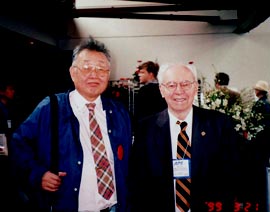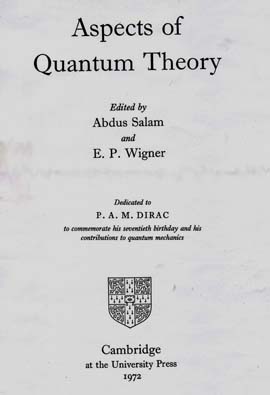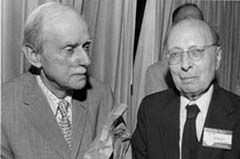Dirac's Polarized Neutrinos

-
When I came to the United States in 1954 to become a Freshman
at the Carnegie Institute of Technology (now called Carnegie-Mellon
University), I was interested in studying
Electrical Engineering.
After hearing about Carnegie Tech's cyclotron, I decided to study
physics. The Carnegie Cyclotron was able to produce 450-Mev protons
and was one of the four most advanced accelerators in the world.
During the summer of 1957 after my junior year, I was fortunate enough to work there as a student helper. I did not understand what was going on too well, but my job was to construct a remote control system for a magnet with variable field strength. It was an exciting experience for me because I was an electronics bug during my high-school years.
As I recall, my professors and his associates were interested in testing whether neutrinos are polarized. Those 450-Mev protons were able to produce tons of pi mesons. When those pions are stopped in a carbon target, they produced also tons of muons and neutrinos. They were interested in testing whether those muons were polarized along the direction of momentum. Those muons can be stopped at another carbon target, and made to precess before decaying into elections and photons. By measuring the angular distribution of electrons, it was possible to measure the muon polarization.
I do not know what happened to their experiment, because we never heard about it in the literature. I assume that their result was not published because they could not find electrons coming from muons. If that was the case, it was the first experiment proving the muon-number conservation.
 In 1957, Maurice Goldhaber and his team carried out their experiment
showing indeed neutrinos are polarized. Here is my photo with
Goldhaber taken at the APS centennial meeting held in Atlanta,
Georgia in March of 1999. During my post-PhD career starting from
1961, I had my up and down years. During my down years, my "closest
friends" would not talk to me. But Maurice was different. He was
always kind to me and gave me encouraging words. He naturally
became very happy whenever I talk about neutrino polarizations.
In 1957, Maurice Goldhaber and his team carried out their experiment
showing indeed neutrinos are polarized. Here is my photo with
Goldhaber taken at the APS centennial meeting held in Atlanta,
Georgia in March of 1999. During my post-PhD career starting from
1961, I had my up and down years. During my down years, my "closest
friends" would not talk to me. But Maurice was different. He was
always kind to me and gave me encouraging words. He naturally
became very happy whenever I talk about neutrino polarizations.
I of course had my own reasons to talk about the polarization of neutrinos. With my co-authors, I published a number of papers on neutrino polarizations as a consequence of gauge invariance. Indeed, the neutrino polarization is a consequence of the E(2) invariance of Wigner's little group for massless particles.
You know the Dirac equation. Did you know that Wigner's E(2) invariance is built into the Dirac equation? If did not, write down the Dirac equation with the gamma matrices in the Weyl representation, and take the zero-mass limit. Then you get the polarized neutrinos.
However, for many years, these polarized neutrinos were not accepted on the grounds that they violate parity invariance. Indeed, the parity violation experiment of 1956 and neutrino polarization experiment of 1957 resurrected polarized neutrinos predicted by the Dirac equation.
I am very happy to present the following table for the Dirac equation with a photo of Dirac and Wigner.
|
|
I had a similar covariance table in one of my earlier webpages on Dirac's physics.
Indeed, the neutrino polarization of 1957 is a confirmation of the E(2) symmetry or the Dirac equation, even though it is widely known as one of the parity-violation experiments.
 This could have been seen by Wigner and Dirac if they had worked
together, but they did not. These two brothers-in-law had
a great respect for each other, but they never attempted to
collaborate in physics. Since I worked with Wigner, I know
how much Wigner knew about Dirac's papers. When I talked with
Dirac in 1972, I was mentioning Wigner's paper published in
a volume dedicated to Dirac's 70th birthday. Dirac was aware
of this book, but was not aware of Wigner's contribution in the
book.
This could have been seen by Wigner and Dirac if they had worked
together, but they did not. These two brothers-in-law had
a great respect for each other, but they never attempted to
collaborate in physics. Since I worked with Wigner, I know
how much Wigner knew about Dirac's papers. When I talked with
Dirac in 1972, I was mentioning Wigner's paper published in
a volume dedicated to Dirac's 70th birthday. Dirac was aware
of this book, but was not aware of Wigner's contribution in the
book.
This kind of gap is not uncommon in the academic world. It can sometimes bring a gold mine of physics. I seem to enjoy talking about the gaps.
Y. S. Kim (2008.3.11)
In 1957, my professor at the Carnegie Tech cyclotron was Robert T. Siegel. He was very nice and helpful to me. In 1961, he moved to the College of William and Mary to build NASA's space-lab cyclotron. This NASA machine was the pre-historic version of the present-day Jefferson Lab accelerator. I am very happy to mention Professor Siegel. He could have been the first one to discover the conservation of nuon number.
Sometimes, no findings could lead to a new discovery. The Michelson-Morley experiment is a case in point.
I also had other excellent professors at Carnegie Tech. I should mention Michel Baranger and Lincoln Wolfenstein. I was fortunate enough to have photos with them in 1997. How can I forget Hugh Young. He wrote a number of excellent text books in physics. You must recognize his name. He was a good teacher.
There are five other webapges based on my years in Pittsburgh.
copyright@2008 by Y. S. Kim, unless otherwise specified.
